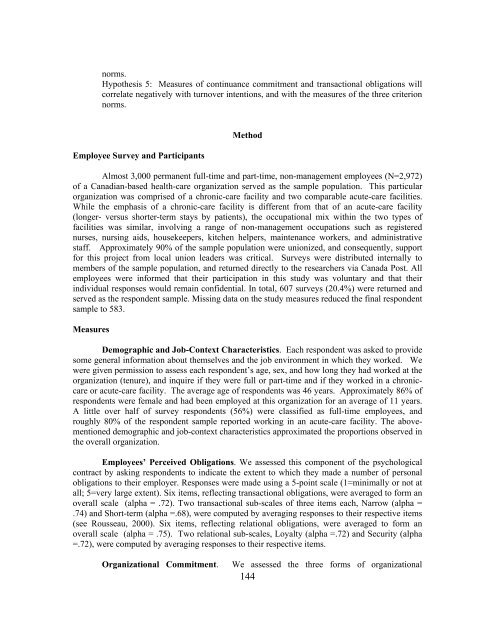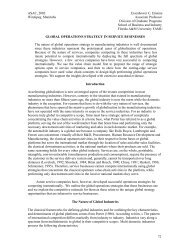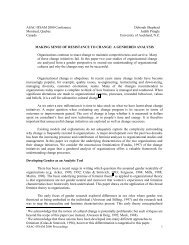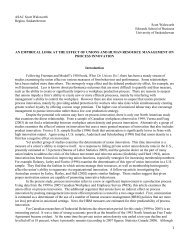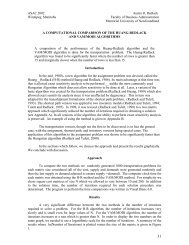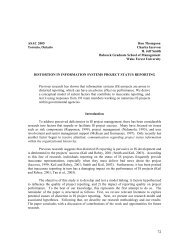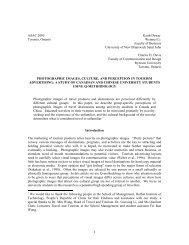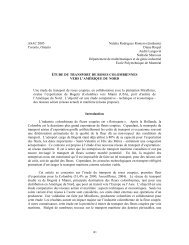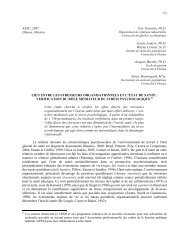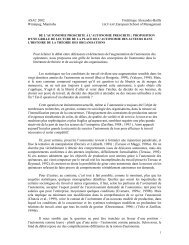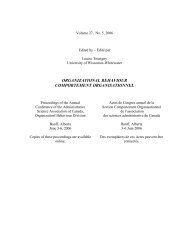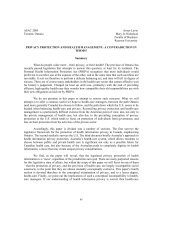norms.Hypothesis 5: Measures of continuance commitment and transactional obligations willcorrelate negatively with turnover intentions, and with the measures of the three criterionnorms.Employee Survey and ParticipantsMethodAlmost 3,000 permanent full-time and part-time, non-management employees (N=2,972)of a Canadian-based health-care organization served as the sample population. This particularorganization was comprised of a chronic-care facility and two comparable acute-care facilities.While the emphasis of a chronic-care facility is different from that of an acute-care facility(longer- versus shorter-term stays by patients), the occupational mix within the two types offacilities was similar, involving a range of non-management occupations such as registerednurses, nursing aids, housekeepers, kitchen helpers, maintenance workers, and administrativestaff. Approximately 90% of the sample population were unionized, and consequently, supportfor this project from local union leaders was critical. Surveys were distributed internally tomembers of the sample population, and returned directly to the researchers via Canada Post. Allemployees were informed that their participation in this study was voluntary and that theirindividual responses would remain confidential. In total, 607 surveys (20.4%) were returned andserved as the respondent sample. Missing data on the study measures reduced the final respondentsample to 583.MeasuresDemographic and Job-Context Characteristics. Each respondent was asked to providesome general information about themselves and the job environment in which they worked. Wewere given permission to assess each respondent’s age, sex, and how long they had worked at theorganization (tenure), and inquire if they were full or part-time and if they worked in a chroniccareor acute-care facility. The average age of respondents was 46 years. Approximately 86% ofrespondents were female and had been employed at this organization for an average of 11 years.A little over half of survey respondents (56%) were classified as full-time employees, androughly 80% of the respondent sample reported working in an acute-care facility. The abovementioneddemographic and job-context characteristics approximated the proportions observed inthe overall organization.Employees’ Perceived Obligations. We assessed this component of the psychologicalcontract by asking respondents to indicate the extent to which they made a number of personalobligations to their employer. Responses were made using a 5-point scale (1=minimally or not atall; 5=very large extent). Six items, reflecting transactional obligations, were averaged to form anoverall scale (alpha = .72). Two transactional sub-scales of three items each, Narrow (alpha =.74) and Short-term (alpha =.68), were computed by averaging responses to their respective items(see Rousseau, 2000). Six items, reflecting relational obligations, were averaged to form anoverall scale (alpha = .75). Two relational sub-scales, Loyalty (alpha =.72) and Security (alpha=.72), were computed by averaging responses to their respective items.<strong>Organizational</strong> Commitment.We assessed the three forms of organizational144
commitment, affective commitment, continuance commitment, and normative commitment,using a condensed form of the scales described by Meyer and Allen (1991; 1997). Each form ofcommitment was assessed using the three items with the highest loadings on their respectivecommitment factor (see Meyer, Allen, & Smith, 1993). For each item, respondents were asked toindicate the extent of their personal agreement using a 6-point scale (1=strongly disagree;6=strongly agree). Item responses were then averaged to form scales for affective commitment(alpha = .89), continuance commitment (alpha=.77), and normative commitment (alpha=.80).Our three-item scales were found to be slightly more reliable than the average, sample-weightedreliability estimates for 6- and 8-item scales across studies and organizational settings (Meyer etal., 2002).Motivational Process Variables. Several motivational process variables were assessedincluding respondents’ turnover intentions and several normative perceptions across threecriterion domains. Respondents’ intentions to leave the organization were assessed using thefollowing three items previously used by Colarelli (1984). Respondents indicated the extent oftheir personal agreement with these three items on a 6-point scale (1=strongly disagree;6=strongly agree) (alpha=.72). We assessed perceived norms by asking respondents to reflect ontheir observations of others in their work areas and report behavior that was typical, average, ornormal. To facilitate this process, we used the relative percentile method (RPM; Goffin, Gellatly,Paunonen, Jackson, & Meyer, 1996). The RPM requires raters to compare the target’s behavior(in this case, the behavior of their immediate coworkers) to a reference group (in this case, theorganizational “average”). The RPM consists of a 101-point scale (ranging from 0 to 100). The15th, 50th, and 85th points on the scale were anchored, respectively, with the terms "BelowAverage," "Average for this Organization," and "Above Average." Respondents were theninstructed to mark the point along this scale that best reflected their observations. In total,respondents made seven RPM ratings: (a) persisting with enthusiasm and extra effort on the job;(b) volunteering to do tasks that are not formally part of the job; (c) helping and cooperating withothers (without being asked); (d) following organizational rules and procedures; and (e)endorsing, supporting, and defending organizational objectives; (f) performing one’s formalduties as outlined in the job description; and (g) attendance. The first five RPM ratings (a-e)corresponded to Borman and Motowidlo’s (1993) five dimensions of contextual performance.These five ratings were averaged to form a measure of the perceived contextual-performancenorm (alpha=.85). The sixth and seventh RPM ratings provided measures of the perceived task(technical) performance norm, and the perceived attendance norm. Although we were unable tocompute the reliability of the two latter measures, it has been documented that .60 is an upperbound estimate of single-item performance ratings (King, Hunter & Schmidt, 1980).Descriptive StatisticsResultsMeans, standard deviations, and zero-order correlations among the study variables aredisplayed in Table 1. The pattern of observed relationships are now reviewed.Insert Table 1 about hereDemographic and Job Context. Several significant relationships among thedemographic and job context variables were noted. A positive correlation between sex and job145
- Page 1 and 2:
Volume 24, No. 5, 2003Edited by/Éd
- Page 4 and 5:
Pursey HeugensGreg IrvingRoderick I
- Page 6 and 7:
TABLE OF CONTENTS - TABLE DES MATI
- Page 8 and 9:
study of power displays in mixed-ge
- Page 10 and 11:
on expectations and behaviour (Berg
- Page 12 and 13:
TaskThis study required the use of
- Page 14 and 15:
Task-Gender (male-stereotyped or fe
- Page 16 and 17:
It is important to understand the s
- Page 18 and 19:
Crown, C.L. & Cummins, D.A. (1998).
- Page 20 and 21:
Smith-Lovin, L., & Brody, C. (1989)
- Page 22 and 23:
Table 2Summary of Descriptive Stati
- Page 24 and 25:
Table 4Summary of Interaction of Ge
- Page 26 and 27:
ASAC 2003Halifax, Nova ScotiaIain L
- Page 28 and 29:
the interrelationships among the MB
- Page 30 and 31:
studies (Friedman and Sarros, 1989;
- Page 32 and 33:
This study demonstrated that emotio
- Page 34 and 35:
Anxiety, Stress and Coping, in pres
- Page 36 and 37:
Washington, DC: Taylor and Francis,
- Page 38 and 39:
Table 2Overall Goodness-of-Fit Indi
- Page 40 and 41:
ζ 3Depersonalizationη 3β 3,1 (+)
- Page 42 and 43:
ASAC 2003Halifax, Nova ScotiaWendy
- Page 44 and 45:
views independently, gave rise to S
- Page 46 and 47:
track assistant, associate, and ful
- Page 48 and 49:
ole conflict are positively related
- Page 50 and 51:
Table 3. Regression of climate and
- Page 52 and 53:
interests.We speculate the null eff
- Page 54 and 55:
DOOP and short for DOOP scales,”
- Page 56 and 57:
Pelled, L. H., “Demographic diver
- Page 58 and 59:
esulting increase in discretion ove
- Page 60 and 61:
al., 1995). However, the distinctio
- Page 62 and 63:
ise to strong pressures for conform
- Page 64 and 65:
presented with a complete list of a
- Page 66 and 67:
Table 3QAP Regression Coefficients
- Page 68 and 69:
ConclusionResearchers of social inf
- Page 70 and 71:
suggestions for further research.
- Page 72 and 73:
performing on the job.” Presumabl
- Page 74 and 75:
positively related to performance i
- Page 76 and 77:
proposed hypotheses were supported.
- Page 78 and 79:
ConclusionThis research has made se
- Page 80 and 81:
Be more enthusiastic and exert extr
- Page 82 and 83:
Table 2Correlations Among the Laten
- Page 84 and 85:
performance expectations on feedbac
- Page 86 and 87:
changements qui s’opèrent dans l
- Page 88 and 89:
structures, politiques, systèmes,
- Page 90 and 91:
comportements liés à la communica
- Page 92 and 93:
Tableau 2Échelles de mesure de la
- Page 94 and 95:
prédiction des compétences clés
- Page 96 and 97:
organisation n’est pas uniforme e
- Page 98 and 99:
complètement ce construit. Ces cha
- Page 100 and 101: Wagner, R.K. and Sternberg, R.J. (1
- Page 102 and 103: What is a toxin handler?In two arti
- Page 104 and 105: potentially limited scope and conte
- Page 106 and 107: work role demands. In this survey,
- Page 108 and 109: The three factors in this rotated f
- Page 110 and 111: and service orientation, the abilit
- Page 112 and 113: ASAC 2003Halifax, Nova ScotiaLisa M
- Page 114 and 115: self-appraisal group reacted more n
- Page 116 and 117: effect of voice are the value-expre
- Page 118 and 119: “Strongly Disagree” to “Stron
- Page 120 and 121: esults suggest that incorporating s
- Page 122 and 123: Personality and Social Psychology,
- Page 124 and 125: Table 1Means, Standard Deviations,
- Page 126 and 127: Table 3Test of the Mediating Role o
- Page 128 and 129: ASAC 2003Halifax, Nova ScotiaAnn Fr
- Page 130 and 131: individual level, polychronicity is
- Page 132 and 133: construct.Drawing on computer-media
- Page 134 and 135: Consequence: Impact on Work Overloa
- Page 136 and 137: Conversation complexity may also mo
- Page 138: Implications for practiceFuture res
- Page 141 and 142: ReferencesAncona, D.G., Goodman, P.
- Page 143 and 144: no. 3 (1994): 381-391.Macan, T.H.,
- Page 145 and 146: ASAC 2003Halifax, Nova ScotiaIan R.
- Page 147 and 148: Assessing Measures: Affective Commi
- Page 149: implications of psychological contr
- Page 153 and 154: Motivational Process Variables. Amo
- Page 155 and 156: DiscussionThe main purpose of this
- Page 157 and 158: approaches zero. In the present stu
- Page 159 and 160: Extension and test of a three-compo
- Page 162 and 163: Table 1Descriptive Statistics and Z
- Page 164 and 165: Table 3Standardized Factor Loadings
- Page 166 and 167: Table 5Hierarchical Regression Anal
- Page 168 and 169: ASAC 2003Halifax, Nova ScotiaJoan F
- Page 170 and 171: ASAC 2003Halifax, Nova ScotiaArla D
- Page 172 and 173: ASAC 2003Halifax, Nova ScotiaIvy Ky
- Page 174: ASAC 2003Halifax, Nova ScotiaNina D


